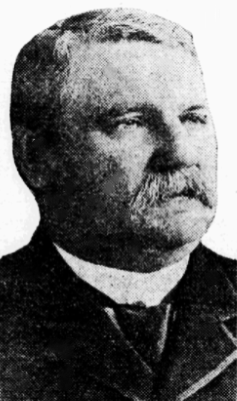Title: Tavern owner
Birthdate: August 10, 1823
Death Date: July 5, 1911
Plot Location: Section 41, Lot 12, west half

It’s extremely rare to find a gravestone that mentions a person other than the one buried there, but this this man’s marker (shown below) includes a reference to Napoleon Bonaparte. The children of George Young wanted it written in stone that his father, Jacob, was a soldier in the Emperor’s army when it fell at the Battle of Waterloo in 1815.
George was born in the Alsace-Lorraine region of what today is part of France. For the previous 300 years, however, its political status had been contested between France and various German states.
Hunger and the lack of housing and employment after the Napoleonic Wars led many families to seek refuge in Paris or even Austria. The Youngs chose to immigrate to America, arriving in 1830. The passenger list said Jacob was a farmer coming from Switzerland with his wife Eva, daughters Magdalena and Eve, and sons George and Jacob. They settled in the Northern Liberties section of Philadelphia.
 Something else that was unique about George, according to his obituary, was that he had held a liquor license for 68 years, longer than any other liquor dealer in the city. He first applied in 1843 when he was 20 (and contrary to this headline, he died at age 87). He got his marriage license a year before his liquor license when he married Ann Weible. The first of their 14 children was born in 1844.
Something else that was unique about George, according to his obituary, was that he had held a liquor license for 68 years, longer than any other liquor dealer in the city. He first applied in 1843 when he was 20 (and contrary to this headline, he died at age 87). He got his marriage license a year before his liquor license when he married Ann Weible. The first of their 14 children was born in 1844.
His obituary said he was a saloon keeper, the census in 1860 simply said “Tavern,” and in 1880 he called himself a hotel keeper, but it was the sale of drinks that provided a good life for George’s family. It was only briefly interrupted by a 16-month stint in the Army.
He was 37, twice the age of most Civil War enlistees, when he was “mustered in” on August 1, 1861 with the rank of 2nd Lieutenant. The unit didn’t engage in any fighting until the Seven Days Battles near Richmond in June of 1862. He served under another Philadelphian, Colonel William “Buck” McCandless, who is buried here, across the creek in Section 107. His notable life story can be found here.
Both George and Col. McCandless were wounded during the Second Battle of Bull Run on August 28-30. After three months on the injured list, George resigned December 3 due to his disability. He returned to his family and his bar at 41st and Haverford Avenue. In 1872 he moved their home and opened a saloon about a mile farther out Lancaster Avenue in the Hestonville neighborhood.
The Panic of 1873 kicked off the Long Depression that lasted through the rest of the decade. Many workers during the latter years of the 19th century suffered under miserable conditions, and they pushed back against working 12-hour shifts, six days a week for low pay. Since Sunday was the only day off, those who didn’t seek comfort and comradery in church found it the night before at the local tavern. Some historians say businesses like George’s filled an important need for socialization when life’s pressures seemed unbearable.
His brother Jacob worked with him for a short time at a second location. Then his son, George Jr. took up bartending as his career. Although Ann died in 1888, George had the companionship of his spinster daughter Clara until she died in 1901 and his widowed daughter Lydia. The 1910 census shows 5148 Lancaster Avenue was also home for his daughter Mary and her husband, who was also a bartender.
 George died of arteriosclerosis in 1911 and divided his estate among the children, except for the tavern. He left that to George Jr., expressing his desire that it continue to operate as long as his son could do so. How long that was is not known. Ironically, it was just one year before Junior died in 1934 that the Pennsylvania Liquor Control Board was established, and for many years they’ve operated a “State Store,” now known as “Fine Wine & Good Spirits,” just across the street from where the Youngs’ tavern once stood.
George died of arteriosclerosis in 1911 and divided his estate among the children, except for the tavern. He left that to George Jr., expressing his desire that it continue to operate as long as his son could do so. How long that was is not known. Ironically, it was just one year before Junior died in 1934 that the Pennsylvania Liquor Control Board was established, and for many years they’ve operated a “State Store,” now known as “Fine Wine & Good Spirits,” just across the street from where the Youngs’ tavern once stood.
George’s father’s name, Jacob, is flanked at the top of this gravestone by his birth and death dates, 1790-1852. To the left it reads, “Native of France,” and to the right, “Soldier of Napoleon I.” (Jacob was buried at Odd Fellows Cemetery, and there is no documentation that he was ever moved here.) Beneath that line on the left are four of the children of George and Ann. His brother Jacob, who died a year after George, is listed on the right side along with several others whose relationships are unknown.

Support the Friends of Mount Moriah
Help us in our mission to restore and maintain the beautiful Mount Moriah Cemetery by donating to our cause or volunteering at one of our clean-up events.

